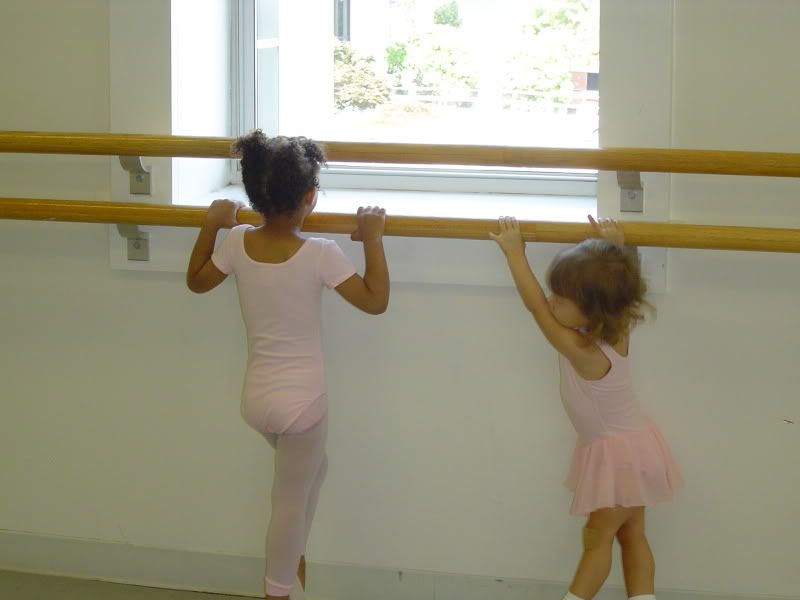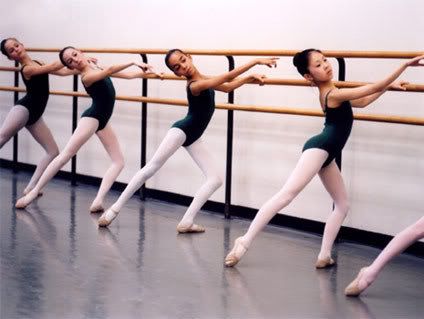Listed below are some of the steps, positions and terms we have been learning. There is also a definition for each term and a picture or video for some terms. New terms and steps will be added to the list as we learn them. Some of the pronunciations of the words are written in brackets.
A
Allegro Brisk and lively. In ballet, allegro refers to steps of elevation (jumps). Petit Allegro means small jumps such as sautes, petit jete and pas de chat. Grand Allegro means large jumps such as Grand Jetes (leaps) (The dancers in the clip below are performing Grand Allegro)
Arabesque A position of the body, in profile, supported on one leg, which can be straight or demi-plié, with the other leg extended behind, and the arms held in various positions creating the longest possible line from the fingertips to the toes. The shoulders must be held square to the line of direction.

en Arriere (on arri air) Backward. When a step is executed (performed) in a backward moving direction.
en Avant (on a von )Forward, When a step is executed (performed) in a forward moving direction.
Attitude A ballet postion in which one leg is lifted and bent at the knee at an angle of 90 degrees.
B
Balance (ba lon say) Rocking step. This step is very much like a pas de valse, shifting the weight from one foot to the other. (The first step the dancers are performing in the clip below is 'balance')
Ballerina A principal female dancer in a ballet company.
Ballon Bounce. Ballon is the light, elastic quality in jumping in which the dancer bounds up from the floor, pauses a moment in the air and descends lightly and softly, only to rebound in the air like the smooth bouncing of a ball.
Barre The horizontal wooden bar fastened to the walls of the ballet classroom or rehearsal hall which the dancer holds for support.

C
Chase (shasay) To slide.
de Cote (de coat ay) Sideways. Used to indicate that a step is to be made to the side, either to the right or to the left. (The dancers in the clip above are performing "balance de cote", ie. balance to the side)
Chase (shasay) To slide.
de Cote (de coat ay) Sideways. Used to indicate that a step is to be made to the side, either to the right or to the left. (The dancers in the clip above are performing "balance de cote", ie. balance to the side)
Croise (quo zay) Crossed. The crossing of the legs with the body placed at an oblique angle to the audience.
Coupe (coup ay) A linking step in which the working foot displaces the supporting foot (cuts it away).
D
Degage (de ga jay) The working leg is extended with the foot pointed on the ground.
Demi Plie (demi plee ay) Half-bend of the knees. All steps of elevation (jumps) begin and end with a demi-plié.
sur les Demi Pointe On the half-points. Indicates that the dancer is to stand high on the balls of the feet and under part of the toes. Also used in the singular, "sur la demi-pointe."
Derriere (de ree air) Behind, back. This term may refer to a movement, step or placing of a limb in back of the body. In reference to a particular step, the addition of derrière implies that the working foot is closed at the back.
Devant (de von) In front. This term may refer to a step, movement or the placing of a limb in front of the body. In reference to a particular step the addition of the word "devant" implies that the working foot is closed in the front.
E
Echappe (e shap ay) Escaping or slipping movement. An échappé is a level opening of both feet from a closed to an open position. There are two kinds of échappés: échappé sauté, which is done with a spring from the fifth position and finishes in a demi-plié in the open position, and échappé sur les pointes, or demi-pointes, which is done with a relevé and has straight knees when in the open position. In each case échappés are done to the second or fourth position, both feet traveling an equal distance from the original center of gravity.
Elevation Élévation is the ability of a dancer to attain height in dancing. It is a term used to describe the height attained in springing steps such as sautes, combined with ballon so that the dancer jumps with a graceful elasticity like the bouncing movement of a rubber ball which touches the ground a moment and then rebounds into the air. The elevation is reckoned by the distance between the pointed toes of the dancer in the air and the ground.
F
en Face (on fas) Opposite (the audience); facing the audience.
Fondu Sinking down. A term used to describe a lowering of the body made by bending the knee of the supporting leg. In some instances the term fondu is also used to describe the ending of a step when the working leg is placed on the ground with a soft and gradual movement. (The girls below are at the barre performing a degage derriere a terre en fondu - ie a point to the back on the ground with a bent supporting leg)

J
petit Jete (petty je tay) The supporting foot springs from the floor and the landing is made in fondu on the working leg with the other foot extended in the air or sur le cou-de-pied (on the ankle).
L
en l'air (on lair) In the air. When the working leg is raised off the ground.
O
Ouvert (oo vair) Open, opened. This may refer to positions (the second and fourth positions of the feet are positions ouvertes), limbs, directions, or certain exercises or steps.
P
Pas (pa) Step. A simple step or a compound movement which involves a transfer of weight.
Pas de bourree (pa de bor ray) One of the simplest connecting steps, used to link other steps in a combination.
Pas de chat (pa de shar) Step of the cat. The step owes its name to the likeness of the movement to a cat's leap. A jumping step where the legs make a diamond shape in the air.
Pirouette Whirl or spin. A complete turn of the body on one foot, on point or demi-pointe. Pirouettes are performed en dedans, turning inward toward the supporting leg, or en dehors, turning outward in the direction of the raised leg. Correct body placement is essential in all kinds of pirouettes. The body must be well centered over the supporting leg with the back held strongly and the hips and shoulders aligned. The force of momentum is furnished by the arms, which remain immobile during the turn. The head is the last to move as the body turns away from the spectator and the first to arrive as the body comes around to the spectator, with the eyes focused at a definite point which must be at eye level. This use of the eyes while turning is called "spotting." Pirouettes may be performed in any given position, such as sur le cou-de-pied, en attitude, en arabesque, à la seconde, etc.
(This clip shows students performing amazing triple pirouettes)
en pointe (on point) Dancing on the tips of the toes while wearing pointe shoes.
pointe shoes Ballet shoes which have reinforcement in the toes to enable a ballerina to stand on her toes with support for her feet.
Port de bras (paw de bra) Carriage of the arms. The term port de bras has two meanings: (1) A movement or series of movements made by passing the arm or arms through various positions. The passage of the arms from one position to another constitutes a port de bras. (2) A term for a group of exercises designed to make the arms move gracefully and harmoniously. In the Cecchetti method there are eight set exercises on port de bras. In the execution of port de bras the arms should move from the shoulder and not from the elbow and the movement should be smooth and flowing. The arms should be softly rounded so that the points of the elbows are imperceptible and the hands must be simple, graceful and never flowery.
Positions of the Feet There are five basic positions of the feet and arms.
R
pointe shoes Ballet shoes which have reinforcement in the toes to enable a ballerina to stand on her toes with support for her feet.
Port de bras (paw de bra) Carriage of the arms. The term port de bras has two meanings: (1) A movement or series of movements made by passing the arm or arms through various positions. The passage of the arms from one position to another constitutes a port de bras. (2) A term for a group of exercises designed to make the arms move gracefully and harmoniously. In the Cecchetti method there are eight set exercises on port de bras. In the execution of port de bras the arms should move from the shoulder and not from the elbow and the movement should be smooth and flowing. The arms should be softly rounded so that the points of the elbows are imperceptible and the hands must be simple, graceful and never flowery.
Positions of the Feet There are five basic positions of the feet and arms.
 |
| Five positions of the feet. |
Releve (re la vay) Raised. A raising of the body on the points or demi-pointes, point or demi-pointe.
Repetoire - The ballets that a ballet company perform.
S
Saute (so tay) Jumped, jumping. When this term is added to the name of a step, the movement is performed while jumping. As, for example, échappé sauté.
Supporting leg A term used by dancers and teachers for the leg which supports the body so that the working leg is free to execute a given movement.
T
Temps leve (ton levay) Jump on one leg, with the other leg raised in a position.
a terre (ar tair) On the ground. This term indicates: (1) that the entire base of the supporting foot or feet touches the ground; (2) that the foot usually raised in a pose is to remain on the ground with the toes extended.
turn out This is the ability of the dancer to turn his or her feet and legs out from the hip joints to a 90-degree position. This turn-out, or en-dehors, is one of the essential principles of the classical dance, giving the dancer freedom of movement in every direction.
Tutu (too too) This is the short classical ballet skirt made of many layers of tarlatan or net. The romantic tutu is the long skirt reaching below the calf.
W
Working leg A term used by dancers and teachers to denote the leg that is executing a given movement while the weight of the body is on the supporting leg.